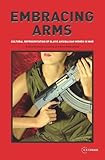Embracing Arms : Cultural Representation of Slavic and Balkan Women in War / ed. by Yana Hashamova, Helena Goscilo.
Material type: TextPublisher: Budapest ; New York : Central European University Press, [2022]Copyright date: ©2012Description: 1 online resource (364 p.)Content type:
TextPublisher: Budapest ; New York : Central European University Press, [2022]Copyright date: ©2012Description: 1 online resource (364 p.)Content type: - 9786155225567
- 355.02082 23
- P96.W352 E8524 2012eb
- online - DeGruyter
| Item type | Current library | Call number | URL | Status | Notes | Barcode | |
|---|---|---|---|---|---|---|---|
 eBook
eBook
|
Biblioteca "Angelicum" Pont. Univ. S.Tommaso d'Aquino Nuvola online | online - DeGruyter (Browse shelf(Opens below)) | Online access | Not for loan (Accesso limitato) | Accesso per gli utenti autorizzati / Access for authorized users | (dgr)9786155225567 |
Frontmatter -- Table of Contents -- Preface and Acknowledgments -- Introduction -- WORLD WAR II -- Film and Television -- Chapter 1 Invisible Deaths: Polish Cinema’s Representation of Women in World War II -- Chapter 2 She Defends His Motherland: The Myth of Mother Russia in Soviet Maternal Melodrama of the 1940s -- Chapter 3 Flight without Wings: The Subjectivity of a Female War Veteran in Larisa Shepit’ko’s Wings (1966) -- Chapter 4 Gender(ed) Games: Romance, Slapstick, and Ideology in the Polish Television Series Four Tank Men and a Dog -- Literature, Graphics, Song -- Chapter 5 Rage in the City of Hunger: Body, Talk, and the Politics of Womanliness in Lidia Ginzburg’s Notes from the Siege of Leningrad -- Chapter 6 Graphic Womanhood under Fire -- Chapter 7 Songs of Women Warriors and Women Who Waited -- RECENT WARS -- Chapter 8 “Black Widows”: Women as Political Combatants in the Chechen Conflict -- Chapter 9 War Rape: (Re)defining Motherhood, Fatherhood, and Nationhood -- Chapter 10 Dubravka Ugrešić’s War Museum: Approaching the “Point of Pain” -- List of Contributors -- Index -- Illustration
restricted access online access with authorization star
http://purl.org/coar/access_right/c_16ec
Discursive practices during war polarize and politicize gender: they normally require men to fulfill a single, overriding task—destroy the enemy—but impose a series of often contradictory expectations on women. The essays in the book establish links between political ideology, history, psychology, cultural studies, cinema, literature, and gender studies and addresses questions such as— what is the role of women in war or military conflicts beyond the well-studied victimization? Can the often contradictory expectations of women and their traditional roles be (re)thought and (re)constructed? How do cultural representations of women during war times reveal conflicting desires and poke holes in the ideological apparatus of the state and society?
Mode of access: Internet via World Wide Web.
In English.
Description based on online resource; title from PDF title page (publisher's Web site, viewed 30. Aug 2022)


